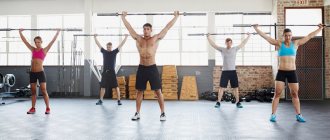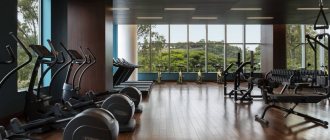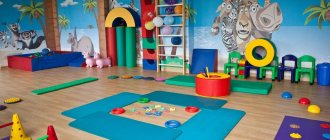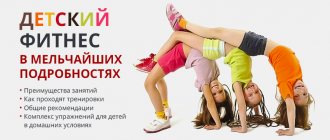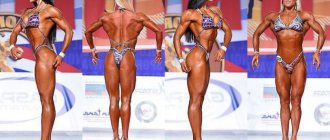Recently, you can increasingly hear such a phrase as children's fitness, but not everyone knows what it is. Many people confuse children's fitness classes with regular physical education, but this is not entirely true, since fitness has a number of advantages. First of all, children's fitness is a sports program developed taking into account the physical fitness and age of the child. In children's fitness classes, children not only develop dexterity and flexibility, but also throw out pent-up energy by playing with other kids.
A little more about children's fitness
Currently, children's fitness is becoming increasingly popular. Such classes are conducted both in sports clubs and in dance schools and children's development studios. Children's fitness is a kind of sports activity that includes elements of gymnastics, choreography, aerobics, yoga and even martial arts. Groups for children's fitness classes usually do not exceed 15 people, and training takes place in the form of a game. This allows the guys to completely relax and enjoy the process.
First of all, children's fitness is a sports program developed taking into account the physical fitness and age of the child.
How do children's fitness classes work?
The lesson begins with a short warm-up. All muscle groups are warmed up, after which the kids are ready to begin basic exercises. The main part of the “lesson” takes place in the form of a game. During this, various balls, ropes, ladders and other equipment are used. At the end of the lesson, everything learned is consolidated
The class is conducted by a children's fitness specialist. In specialized groups, most trainers have a medical education. The coach controls every movement of the children, prompts and corrects where necessary.
The best programs that are used in children's fitness classes
Of course, each sports club follows its own developed program. There are no strict frameworks, the coach dilutes the finished program and introduces something of his own.
The most popular are:
Logo aerobics
It's not just fitness. During classes, children not only perform physical exercises, but also practice speech techniques. Together with the coach they pronounce various sounds and learn small rhymes.
Capoeira
Classes include dance and martial arts. These elements exist together very harmoniously. Kids simply adore these activities.
Animal aerobics
Classes are held in the form of a game of “Zoo”. Children repeat the movements of animals and make sounds imitating growls. They jump, climb ropes and wall bars.
Is it possible to do children's fitness on your own?
It is not always possible to attend classes at a specialized center. You can do it yourself. Of course, you won’t be able to achieve the same results as after attending classes with a trainer. Without special education and training, you can teach your child only basic physical exercises.
The main thing to remember is that children's fitness has one important goal. It develops social skills and teaches the child to live in society without the use of gadgets. Therefore, it is better to attend classes in specialized clubs.
Good luck with your child's classes!
What exercises do the training programs consist of?
It is impossible to name one specific exercise program. Children's fitness is more of a combination of various general strengthening exercises. The lesson may include both posture exercises and exercises with a skipping rope, choreography, swimming and other types of physical activity.
In general, there are a great variety of programs for children’s fitness, and you have the opportunity to choose exactly those activities that are most suitable for your child’s age and temperament and that will allow the child to realize his or her maximum potential.
Benefits of classes
The main positive features of fitness for children include:
- Training does not last long and does not overload the child;
- Aerobics for children involves group (including play) forms of work - accordingly, in addition to physical development, this makes it possible to develop a number of necessary communication skills in children;
- The instructor always practices an individual approach to each student;
- Gymnastics for children is the best choice if the child does not attend preschool and, against this background, experiences a lack of communication and physical activity;
- During training, children develop many useful skills - in particular, flexibility, mobility, coordination, ability to behave in a team, agility, strength, etc.
Any fitness classes will certainly help normalize the child’s body weight; in addition, physical exercise is an excellent prevention of diseases of the cardiovascular system, scoliosis, and damage to the knee joints.
The main advantage of children's fitness is a wide range of activities and, accordingly, the presence of a main motive to engage in: the child's interest in this form of pastime.
Children's fitness and sports sections. What is the difference?
Children's fitness and sports sections have a number of differences. Firstly, fitness is safer; it is almost impossible to get injured during classes. Secondly, in children's fitness there is no such physical stress and psychological pressure as in sports sections. In addition, all children are accepted for children's fitness, but sports sections often have selection based on physical fitness and other parameters. Therefore, children's fitness classes are more suitable for the fragile psyche of children, since children are in equal conditions and can show their potential in classes.
It is worth noting the fact that in children's fitness you can choose for your child exactly the program that he will like. After all, all children are different and have different interests. Some people like active games, others like dancing, and still others like repetition exercises. In addition, recently, logoaerobics techniques have been used in children's fitness classes, when children repeat specially selected poems or tongue twisters while performing a particular exercise. This develops speech and memory in children.
“Modern fitness technologies with preschool children”
“Modern fitness technologies with preschool children”
The trend of “children’s fitness” appeared relatively recently, but its popularity is rapidly growing both abroad and in our country. And, despite the fact that it does not yet have a sufficiently strict scientific basis, it is undoubtedly of interest to specialists in health-improving physical culture.
Widespread promotion of fitness in the media serves as an additional significant argument in favor of choosing such classes.
Children's interest in them is also due to the fact that fitness programs are publicly accessible, highly effective and emotional.
The accessibility of children's fitness areas is determined primarily by the fact that their content is based on simple outdoor equipment and most of them do not require special equipment (with the exception of exercises on exercise machines, steppes, and fitballs).
The effectiveness of various areas of fitness lies in their diverse impact on the musculoskeletal system, cardiovascular, respiratory and nervous systems of the child’s body, the development of motor abilities and the prevention of various diseases.
Modern fitness technologies
"Children's aerobics"
The influence of children's aerobics on the child's body is varied and has a great healing effect: strengthening the musculoskeletal system, the strength of the muscles of the foot and lower leg to prevent flat feet, the formation of correct posture, the development and strengthening of all major muscle groups, helping to increase the functionality of the vegetative organs, improving cardiovascular and respiratory systems, improvement of metabolic processes in the body, optimization of digestion and thermoregulation, improvement of physical abilities (coordination of movements, strength, endurance, speed), formation of basic vital motor skills, increasing interest in physical education. The dance orientation of the exercises and musical accompaniment contribute to the development of a culture of movement, expressiveness, plasticity, grace, rhythm, and musicality.
"Game stretching"
Stretching also has a psychological effect: it improves mood, raises self-esteem, and creates a feeling of comfort and calm in general.
Playful stretching classes help a child develop a sense of rhythm, strengthen muscles, straighten posture, and relieve inhibitions. They are carried out in the form of a role-playing or thematic game, which includes 8-9 exercises for various muscle groups. Children portray different animals and perform exercises accompanied by certain excerpts from classical and folk music.
Stretching exercises are imitative in nature and are performed during a role-playing game, consisting of interconnected situations, tasks, exercises, selected in such a way as to facilitate the solution of health-improving and developmental tasks.
The combination of dynamic and static exercises is most consistent with the nature of the human musculoskeletal system and is the best means of developing physical qualities: strength, agility, endurance, flexibility.
With these exercises
you can start studying
with a child from 3-4 years old.
"Karate-do"
Karate for children, first of all, serves as an excellent system of psychophysical training. Karate classes help improve health, increase the level of vital activity, the body's resistance to adverse environmental factors, and the comprehensive development of motor qualities (strength, flexibility, endurance, speed, coordination of movements).
In addition, karate classes under the guidance of a qualified teacher stimulate the mental development of children - they teach them to concentrate, develop memory, and enrich both logical and imaginative thinking. They strengthen the musculoskeletal system, respiratory and cardiovascular systems.
Karate develops in a child such qualities as determination and hard work, stimulates the manifestation of strong-willed qualities (getting things done to the end, initiative, perseverance and perseverance in overcoming difficulties). Group classes help to find a common language in the team. Karate classes influence the formation of character - a person becomes more self-confident, learns restraint and self-control. Education of children is associated with moral education, the formation of moral and volitional qualities: goodwill and mutual assistance, honesty, justice.
“Imaginative and playful rhythmic gymnastics
”
Imaginative and playful rhythmic gymnastics is a unique harmonious combination of music, imaginative and imitation exercises and games that have an effective and versatile effect on the child’s body and solve certain problems in raising and educating children.
Taking into account the age-related psychological characteristics of preschoolers, each rhythmic gymnastics complex being developed should subordinate it to some plot (for example, “The Winter's Tale”, “The Adventures of Pinocchio”, “Africa”, “The Adventures of Electronics”, “Soon to School”, etc. ). When selecting musical accompaniment for such complexes, it is necessary to take into account the semantic content of the song, which is similar in theme.
Each exercise in the complex must have a name and be performed to its own musical episode. At the same time, the child more easily develops motor associations for a specific phrase from the lyrics of a song, a melody, and he quickly remembers the order of performing movements. The use of imitation and imitation techniques, figurative comparisons corresponds to the psychological characteristics of preschool children, promotes the development of thinking, imagination, creative abilities, and cognitive activity. It is interesting, simple and natural for children to convey images, characters and actions of characters in songs, fairy tales and cartoons using expressive movements.
"Pilates"
Children's Pilates is a specially designed program based on basic Pilates exercises, adapted for children of different ages. You can start practicing as early as three years old.
For children aged 5-6 years, classes are conducted in a playful way; they represent an exciting game and manipulation of visual images. Such popular children's exercises as “Swan dives”, “Penknife opens”, “Turtle”, by their very name explain the essence of the movements. The teacher says: “Let’s imagine ourselves as a turtle that wants to get out of its shell,” and the child, pretending to be a turtle, stretches forward, pulls his head, while his entire spine stretches. Or a hedgehog runs across a clearing and suddenly, frightened by something, curls up into a ball. Following the magical heroes, the children perform exercises, quietly strengthening the muscles of the body, creating a strong muscle corset, developing strength, flexibility and stretching.
"Rhythmic gymnastics"
Under the influence of rhythmic gymnastics classes, children develop sustained attention and composure, which are important prerequisites for successful studies. The dancing manner of performing exercises contributes to the formation of plasticity, expressiveness and elegance, the gait becomes light and graceful. This strengthens self-confidence, the ability to overcome shyness, timidity, and increases self-esteem.
The collective form of rhythmic gymnastics classes meets the characteristics of childhood and makes it possible to freely reveal one’s strengths and abilities. Musical accompaniment, causing emotional uplift and joyful feelings, promotes the aesthetic and musical development of children.
All kinds of jumps and jumping up from a crouching position, swinging movements of the legs and arms, circular movements of the body, performed quickly and with a large amplitude, allow you to increase speed and strength qualities.
"Step aerobics"
The versatility and versatility of the step platform allows it to be used not only as a step for ascending and descending steps of step aerobics, but also as a gymnastic apparatus, as an object, landmark, obstacle or support when performing exercises of different directions.
As an object, the step platform can be transported from place to place, transferred to each other, and performed with a step in the hands of an outdoor gear from various starting positions.
As a reference point, the step platform is convenient for drill exercises, games, relay races, and circuit training.
Expected results:
- a stable equilibrium is formed;
- confidence, ability to navigate in space and precision of movements appear;
- physical qualities increase: agility, speed, general endurance, etc.;
- the risk of cardiovascular diseases is reduced*
- posture is corrected;
- the necessary motor skills are acquired;
- motor memory develops;
- the respiratory system is strengthened;
- activities are returning to normal
- vestibular apparatus,
skill is improving
rhythmically consistent,
understand simple
movements.
"Fitball-gymnastics"
Fitball translated from English means “ball for support”, used for recreational purposes. Exercises on a gymnastic ball help to acquire motor dexterity, coordinate movements and maintain balance. Exercises with a ball strengthen the muscles of the back and abdominals, create a good muscular corset, improve the functioning of the cardiovascular and respiratory systems, communication and emotional-volitional spheres, normalize the functioning of the nervous system, stimulate neuropsychic development, but most importantly, they form complex and long-term skills. under normal conditions, the skill of correct posture.
"Cheerleading"
Cheerleading (cheerleading, from English, cheer - an approving, inviting exclamation and lead - to lead, manage) is a type of physical activity that combines elements of show and spectator sports (dancing, gymnastics and acrobatics).
A specific feature of cheerleading is the frontal and group methods of conducting classes, which guarantee their high density in general and maximum motor activity of each student. Now cheerleading has become actively used in preschool institutions.
It is necessary to note the positive aspects of this innovation:
- the opportunity to develop children's creativity through musical movement;
- increasing the volume of physical activity during the day;
- developing communication skills in collective activities, including in groups of different ages;
- determining the child’s place in the group by establishing his role, which requires special qualities;
- positive
- emotions evoked
- performances at
- to the public.
The popularity of children's fitness is growing. Its external attractiveness and the ability to satisfy various needs in the activities of children and adolescents is also explained by the fact that specialists make significant efforts to attract as many students as possible through the variety of activities, modern methods and forms of their implementation, including with the help of external attributes - fashionable sportswear, accessories, new, beautiful, functional equipment. The very atmosphere of goodwill, increased attention and respect for each student, regardless of his age, has a positive psychological impact and encourages people to come to fitness clubs and additional education institutions again and again.
We wish you and your children health!
At what age can children do fitness?
All healthy children can start children's fitness classes from the age of 3. The main thing is to take into account the age characteristics of the child when doing fitness. For example, children aged 3 years are recommended to exercise no more than 20-30 minutes twice a week. Children aged 5 to 10 years can exercise 2-3 times a week for 30 minutes.
For children 11–14 years old, fitness classes will last 40 minutes, 3 times a week. For this age group, exercise bikes may already be included in the exercise program.
Personal experience
Children's fitness
Children's fitness
Let's go to the gym :))
Does your child need it?
Should you sign up your child for children's fitness? There are no clear indications, but the following can be considered conditional:
- Hyperactivity. If your baby is hyperactive, then in classes he will splash out his energy, because that’s what they are designed for.
- Insufficient physical activity. If the child moves little, then this needs to be corrected urgently, since a decrease in activity can lead to developmental disorders and even some diseases.
- Lack of communication with other children and socialization skills. For example, if for some reason the child does not attend kindergarten, then in fitness classes he will be able to learn how to interact with peers.
- Weak immunity. Regular exercise will help improve your health.
- Some diseases. A specially designed program will help solve some problems, such as flat feet, decreased muscle tone, and so on.
What are the contraindications for children's fitness?
There are practically no absolute contraindications for children's fitness. But if your baby suffers from some chronic diseases, then it is very important to choose the right training program that will improve health and not harm the baby. For example, if a child suffers from asthma, then aerobics should be excluded from his fitness program. More yoga classes may be included instead. For children with spinal problems, any strength exercise is contraindicated, but swimming and aerobics are very useful.
In any case, if your baby suffers from chronic diseases, then any exercise should be started only after consultation with a specialist, and it is best to coordinate the program compiled by a fitness instructor with a doctor, so as not to harm the child’s health.
Section selection
It is important to remember that the circle and its direction should not be a forced decision of the parent. Without the desire to develop further, the child will not achieve the desired results, but will waste his time. Before advising your son or daughter to study, you need to take into account their opinion and ask whether he or she would like to pay attention to this.
You should not categorically prohibit recording, even if it is clear that interest will fade. Let him visit the section - during the classes he will find out whether this is really what he wanted.
In addition, it is rational to ask where your child’s friends or classmates are studying. In a familiar circle, communication and learning will be easier.
Parents can view nearby sections online. A conversation with the coach or students will give a picture of what is happening inside the circle.
You should not choose a gym far from home. If the child gets back on his own, then after grueling activities it will be difficult for him to concentrate along the way. At a younger age, children must be accompanied by their parents. To do this, it is worth allocating the time and days when an adult can bring a young athlete to training.

